Receptor-type tyrosine-protein phosphatase-like N, also called "IA-2", is an enzyme that in humans is encoded by the PTPRN gene. [5] [6]
Receptor-type tyrosine-protein phosphatase-like N, also called "IA-2", is an enzyme that in humans is encoded by the PTPRN gene. [5] [6]
The IA-2 protein encoded by PTPRN gene is a member of the protein tyrosine phosphatase (PTP) family and PTPRN subfamily. PTPs are known to be signaling molecules that regulate a variety of cellular processes including cell growth, differentiation, mitotic cycle, and oncogenic transformation. This PTP possesses an extracellular region, a single transmembrane region, and a single catalytic domain, and thus represents a receptor-type PTP. This PTP was found to be an autoantigen that is reactive with insulin-dependent diabetes mellitus (IDDM) patient sera, and thus may be a potential target of autoimmunity in diabetes mellitus. [6]
IA-2 and IA-2b belong to family of protein tyrosine phosphatase-like (PTP) molecules. IA-2 is a transmembrane protein with 979 amino acids encoded by a gene on human chromosome 2q35. Similarly, IA-2b has 986 amino acids, and it is located on human chromosome 7q36. The IA-2 is synthesised as a pro-protein of 110 kDa which is then converted by post-translational modifications into a 130 kDa protein.
The IA-2 and IA-2b shares 74% identity within the intracellular domains, but only 27% in the extracellular domains.
The IA-2 protein is expressed mainly in cells of neuroendocrine origin, such as pancreatic islets and brain. The IA-2 protein is localised in the membrane of secretory granules of pancreatic β-cells. [7] [8]
Even though the IA-2/b has a similar structure to other PTPs, there is a critical amino acid replacement at position 911 (Asp for Ala), [9] which is required for enzymatic activity. These proteins thus fail to show enzymatic activity and their function remains unclear. [7] They could play role in insulin secretory pathways, sorting out proteins or regulates other PTPs. [10]
The IA-2 is a second major autoantigen in Type 1 Diabetes. IA-2 autoantibodies are found in 78% type 1 diabetics at the time of diagnosis. [11] It has been shown that the autoantibodies exclusively react with the intracellular domain, also called juxtamembrane, but not with the extracellular domain of IA-2/b. [7]
It is suggested that IA-2 and not the IA-2b is the primary PTP-like autoantigen in Type 1 Diabetes. The juxtamembrane region in IA-2 is probably the early antibody target. Followed by multiple epitope spreading which is believed to take place in the early development of the disease. [12]
Autoantibodies targeting pancreatic islet cell can occur years before a hyperglycaemia is established, therefore these autoantibodies are used in prediction of Type 1 Diabetes.
Islet cell autoantibodies are detected in serum, including ICA (islet cell cytoplasma autoantibodies), IAA (autoantibodies to insulin), GAD (glutamic acid decarboxylase), IA-2 (insulinoma-associated protein 2), and ZnT8 (zinc transporter of islet beta cells). [13]
However, it is not clear if a primary autoantigen exists and immune reaction against other molecules results from secondary antigen spreading, or multiple molecules represent a primary target. [14]
The first autoimmune targets are usually aimed against insulin or GAD, and it is unique to observe IA-2 or ZnT8 as the first autoantibodies. What set off the appearance of a first β-cell targeting autoantibody is unclear. [15]
The IAA antibody usually appears early in life, median age is 1.49. Presence of GAD as the first autoantibody is more widespread with median age 4.04. It is relatively rare to see IA-2 as the primary autoantibody, median age 3.03. Interestingly, secondary autoantibodies follow different patterns to mask the primary autoantibodies, if both are combined. If the primary autoantibody is IAA then GAD briskly appears with peak of 2 years age. Secondary IAA usually occurs after GAD, where the age distribution is over wide range. [14]
It is unknown whether the appearance of autoantibodies corresponds with insulitis process in the pancreas and if so, what is the combination of the autoantibodies. [13]

Protein tyrosine phosphatases (EC 3.1.3.48, systematic name protein-tyrosine-phosphate phosphohydrolase) are a group of enzymes that remove phosphate groups from phosphorylated tyrosine residues on proteins:

Receptor tyrosine kinases (RTKs) are the high-affinity cell surface receptors for many polypeptide growth factors, cytokines, and hormones. Of the 90 unique tyrosine kinase genes identified in the human genome, 58 encode receptor tyrosine kinase proteins. Receptor tyrosine kinases have been shown not only to be key regulators of normal cellular processes but also to have a critical role in the development and progression of many types of cancer. Mutations in receptor tyrosine kinases lead to activation of a series of signalling cascades which have numerous effects on protein expression. The receptors are generally activated by dimerization and substrate presentation. Receptor tyrosine kinases are part of the larger family of protein tyrosine kinases, encompassing the receptor tyrosine kinase proteins which contain a transmembrane domain, as well as the non-receptor tyrosine kinases which do not possess transmembrane domains.

Tyrosine-protein phosphatase non-receptor type 11 (PTPN11) also known as protein-tyrosine phosphatase 1D (PTP-1D), Src homology region 2 domain-containing phosphatase-2 (SHP-2), or protein-tyrosine phosphatase 2C (PTP-2C) is an enzyme that in humans is encoded by the PTPN11 gene. PTPN11 is a protein tyrosine phosphatase (PTP) Shp2.
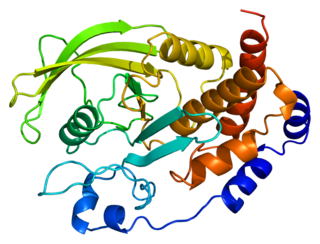
Tyrosine-protein phosphatase non-receptor type 1 also known as protein-tyrosine phosphatase 1B (PTP1B) is an enzyme that is the founding member of the protein tyrosine phosphatase (PTP) family. In humans it is encoded by the PTPN1 gene. PTP1B is a negative regulator of the insulin signaling pathway and is considered a promising potential therapeutic target, in particular for treatment of type 2 diabetes. It has also been implicated in the development of breast cancer and has been explored as a potential therapeutic target in that avenue as well.

Low molecular weight phosphotyrosine protein phosphatase is an enzyme that in humans is encoded by the ACP1 gene.

Receptor-type tyrosine-protein phosphatase alpha is an enzyme that in humans is encoded by the PTPRA gene.

Receptor-type tyrosine-protein phosphatase F is an enzyme that, in humans, is encoded by the PTPRF gene.
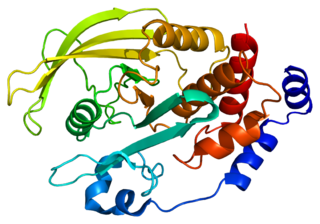
Tyrosine-protein phosphatase non-receptor type 2 is an enzyme that in humans is encoded by the PTPN2 gene.
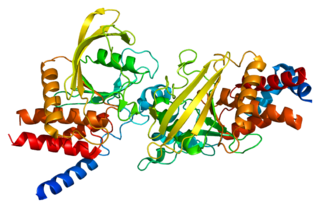
Receptor-type tyrosine-protein phosphatase beta or VE-PTP is an enzyme specifically expressed in endothelial cells that in humans is encoded by the PTPRB gene.

Receptor-type tyrosine-protein phosphatase mu is an enzyme that in humans is encoded by the PTPRM gene.

Protein tyrosine phosphatase type IVA 1 is an enzyme that in humans is encoded by the PTP4A1 gene.

Receptor-type tyrosine-protein phosphatase S, also known as R-PTP-S, R-PTP-sigma, or PTPσ, is an enzyme that in humans is encoded by the PTPRS gene.

Receptor-type tyrosine-protein phosphatase PCP-2, is an enzyme that in humans is encoded by the PTPRU gene.
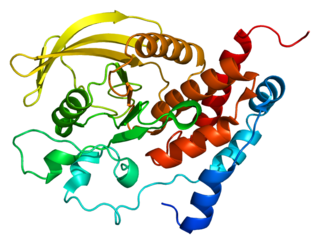
Protein tyrosine phosphatase receptor-type R is an enzyme that in humans is encoded by the PTPRR gene.

Receptor-type tyrosine-protein phosphatase delta is an enzyme that, in humans, is encoded by the PTPRD gene.
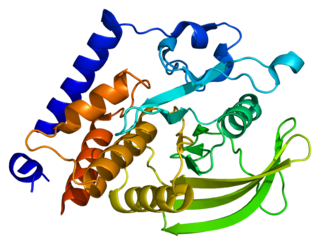
Tyrosine-protein phosphatase non-receptor type 18 is an enzyme that in humans is encoded by the PTPN18 gene.
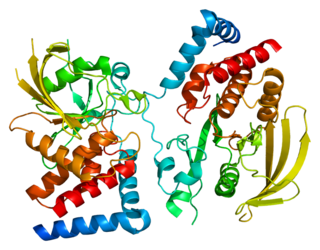
Receptor-type tyrosine-protein phosphatase gamma is an enzyme that in humans is encoded by the PTPRG gene.

Receptor-type tyrosine-protein phosphatase kappa is an enzyme that in humans is encoded by the PTPRK gene. PTPRK is also known as PTPkappa and PTPκ.

Receptor-type tyrosine-protein phosphatase N2 (R-PTP-N2) also known as islet cell autoantigen-related protein (ICAAR) and phogrin is an enzyme that in humans is encoded by the PTPRN2 gene. PTPRN and PTPRN2 are both found to be major autoantigens associated with insulin-dependent diabetes mellitus.
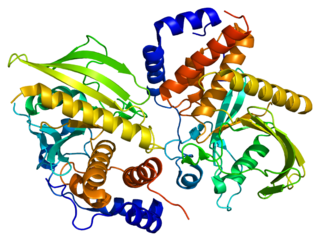
Tyrosine-protein phosphatase non-receptor type 9 is an enzyme that in humans is encoded by the PTPN9 gene.